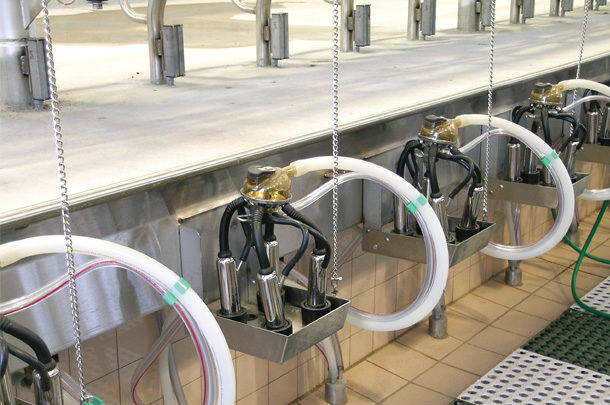Have you ever noticed that on some dairies, milking units are not as clean as on other dairies? Some of this may be related to how often they are cleaned, but there can be other factors at play as well.
How about the fact that some dairies have to replace their milking claws more often or have more claw cuts on their liners than the neighbor dairy? Of course, there are different styles of claws and liners, but there are other factors that may be playing a role as well.
Automatic takeoffs have been used successfully on many dairies for years and have been a benefit to the cow and the farmer, but they can require some fine-tuning to make them work well. One of the areas for fine tuning is the retraction event. This article will explore how to assess the retraction event on your dairy and some tips on troubleshooting what might be wrong if it is not working well.
One of the goals of retraction is to time the sequence of events so that the unit is pulled or retracted away from the teats just as it is falling off the teat. Ideally, we do not want any part of the milking cluster (claw, shells, liners or hoses) to hit the deck or floor as it retracts. As you can imagine, this can be a delicate balance that is hard to achieve perfection on every time.
The basic sequence of events is that when a unit is ready to come off, a signal is sent to the vacuum shut-off device in the system to shut off vacuum to the cluster. Then a second signal is sent to the retraction cylinder to begin retraction. In some systems, there is a delay between these two signals. This delay time has different names in different systems, but a couple common names are vacuum decay time or retract delay time. This delay between vacuum shut off and the start of retraction gives time for the vacuum to decrease in the liners and for the unit to start to pull away from the teats.
Why is it important to get the retraction event right?
As you can imagine, if units are continually hitting the deck at the point of retraction, they have the potential to get much dirtier than if they retract without touching the floor. Dirty units can lead to a higher risk of mastitis because the potential increases to get dirt on the teat or teat end when these units are attached to the next cow. Also, dirty units lead to dirty hands of milkers as they touch the claw and shells to attach the units.
Dirty units mean more work for milkers since they have to clean them off, which slows them down and affects parlor efficiency. Units that hit the deck on retraction also can cause more damage to claws, shells and liners. If units hang onto teats during retraction, many cows react to this by kicking at the unit, which can lead to more dirt and manure on the unit and the unit ending up on the floor as well.
How do you assess the retraction event?
At Quality Milk Production Services, we have developed a simple three-category scoring system to use when we watch the retraction event. The three categories are: 1) Unit hits the deck on retraction; 2) Good retraction or 3) Unit hangs onto teats at retraction.
We will score the retraction event at various times throughout a milking, making sure we have first-lactation and mature cows represented as well as high-production and low-production cows. We also make sure that we watch many different units in the parlor. The intention of the scoring system is to look at the system as a whole.
How do you differentiate whether this is an individual unit problem versus a system problem?
In the course of scoring the retraction event, you may notice that an individual unit always hits the deck on retraction. It is important to look closer at this unit and make sure components are in place for retraction to be successful. For instance, when you look closer, you may notice the retraction cord or chain is not present or is not moving during retraction. You should record the stall number and issue you detected so that you can relay this to management later on, and they can correct the issue.
What are potential issues leading to many units hanging onto teats?
If, as you are scoring, you see too many units that are hanging onto teats at the point of retraction, you need to take an additional step before leaving the parlor. The decay of vacuum in the claw during retraction relies on a vent in the claw or liner being open. Therefore, if units are hanging onto teats, you need to check all claw and liner vents on all the units and record which ones are plugged.
Then, continue watching the retraction event to determine if the units hanging on are related to the plugged vents. If so, then this should be discussed with management and a protocol set in place for the lead milkers to open all vents at the start of each milking. Also, all milkers should be trained on what to look for during the retraction event to signal them to check the vent on that unit.
If all vents are open and there are still units hanging onto teats during retraction, then explore whether the vacuum is actually being shut off at retraction. This can be tested with the unit off the cow, if need be. If the vacuum is still on during retraction, then the unit number should be noted and the milking equipment dealer notified as to what was found so this can be corrected as soon as possible. On a recent herd investigation, we found this to be the case on 28% of the units on one large dairy.
If vents are open and the vacuum is shutting off, then the next step is to explore whether the vacuum decay time can be lengthened. I recommend you contact the milking equipment dealership and present your data to them with the suggestion of lengthening the vacuum decay time. This step would give more time for the vacuum to drop in the claw before the unit is retracted. Changes in the vacuum decay time should be made in small increments and a reassessment made after each change.
What are potential issues leading to units hitting the deck?
If you notice that a large number of units are hitting the deck on retraction, then the issue may be that the vacuum decay time is too long. As noted above, I recommend you involve the equipment dealer in the conversation about shortening the vacuum decay time.
If the vacuum decay time is at zero seconds and units are still hitting the deck, there may be an issue with how quickly the retraction is occurring. On a recent herd investigation, this was the situation we found as we timed the retraction event. The retraction event was timed with the unit not on the cow but by simply pushing the retract button and timing how long it took for the unit to be fully retracted.
Over 50% of the units showed a delayed retraction compared to the rest of the units, and this correlated well to the units which were seen to hit the deck. This situation was discussed with the owner who was going to contact the dealership to request maintenance on the retraction cylinders.
On another dairy, it was determined that the retraction chain was getting caught in the cabinet on retraction, leading to a slower retraction. This dairy set in place a procedure for replacing the bushing the chain ran through in order to correct this issue.
Hopefully this article has helped to shed some light on how to assess the retraction event on your dairy or a dairy that you work with. Ideally, when you look at this on the next dairy you are on, you will see a perfectly timed retraction event, in which the cow does not even seem to notice that the unit is being removed. In case you do not, though, work through the steps above in order to fine-tune this critical component of the milking event. Good luck, and the cows will thank you.







